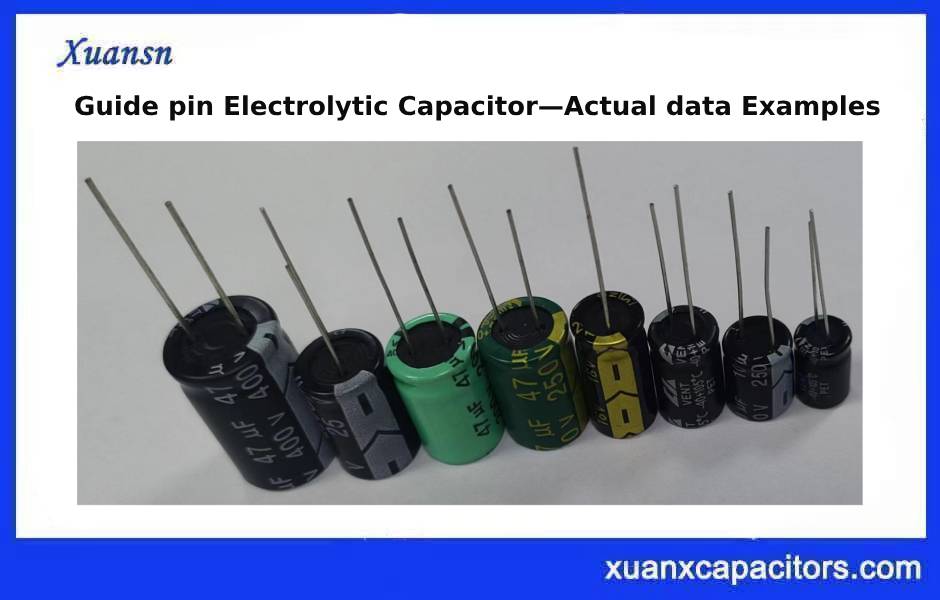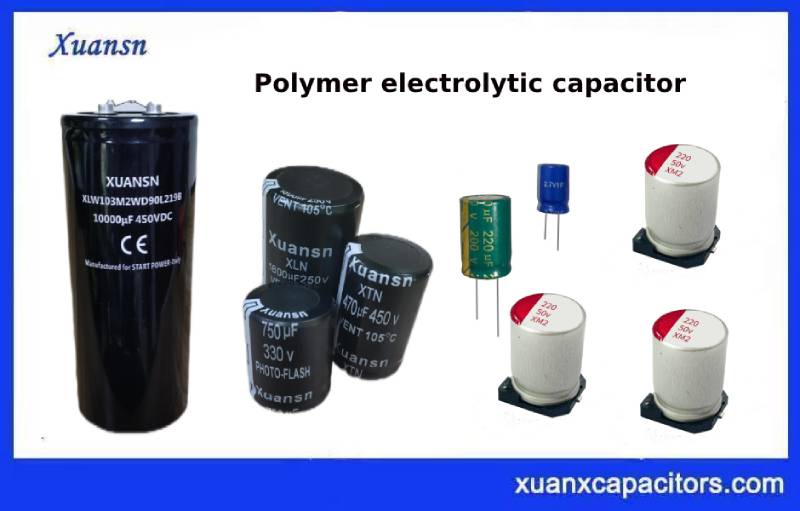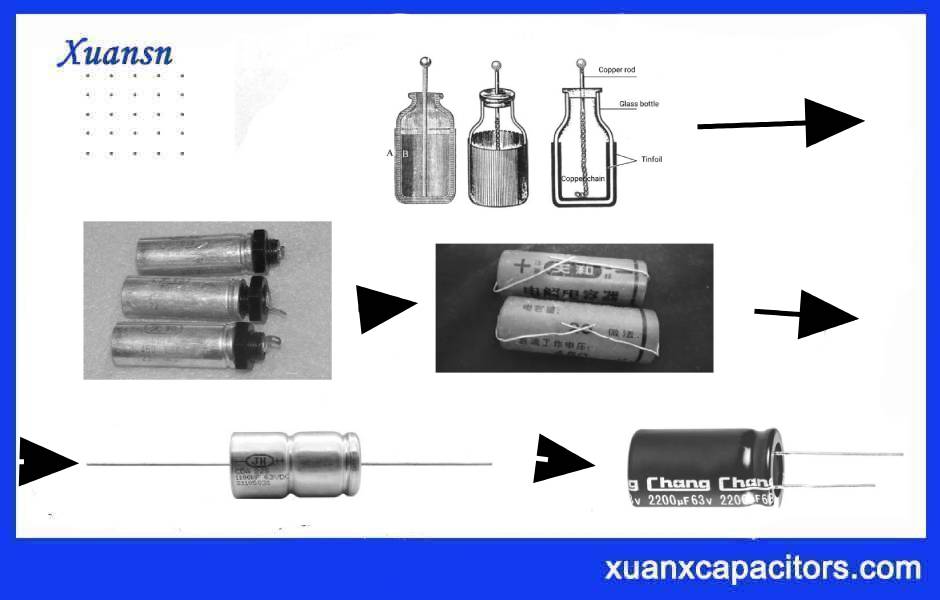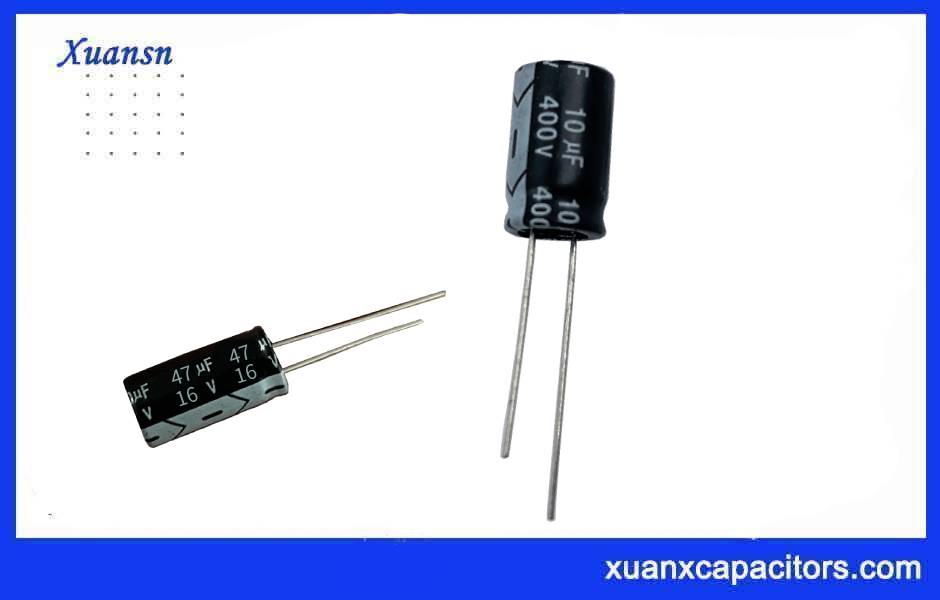1 Failure Of Aluminum Electrolytic Capacitors
Factors causing the failure of aluminum electrolytic capacitors include drying up of the electrolyte, action of the pressure relief device, short circuit, open circuit (no capacitance), excessive leakage current, etc. These are common failure factors.
Therefore, the factors causing the failure of aluminum electrolytic capacitors can be divided into two parts: the characteristics of the aluminum electrolytic capacitor itself and the application environment of the aluminum electrolytic capacitor.
2 Characteristics of aluminum electrolytic capacitors
This includes the selection and formulation of manufacturing materials (pole pieces, electrolyte, sealing, etc.), manufacturing processes and technologies (sealing methods, heat dissipation technology, etc.).
2.1 Manufacturing materials
In a pure capacitor, no electrochemical reaction should occur. This is the essential difference between a capacitor and a battery.
The electrochemical reaction in the battery can output or store electrical energy, but the electrochemical reaction that occurs in the capacitor not only does not output or store electrical energy, but also damages or even damages the capacitor.
Due to the presence of electrolyte in aluminum electrolytic capacitors, once impurities are present in the electrode material, a galvanic cell effect will occur, causing excessive leakage current and corrosion of the aluminum electrode. Therefore, the aluminum used in aluminum electrolytic capacitors must be high-purity aluminum, and no other impurities can be doped during the manufacturing process of aluminum electrolytic capacitors.
Since the medium of aluminum electrolytic capacitors is alumina, once chloride ions exist in the electrolyte, the chloride ions will replace the oxygen ions in the alumina and become aluminum chloride, which will dissolve in the electrolyte, thereby destroying the alumina medium and causing an increase in leakage current. To the extent that it cannot be used or even cause a short circuit.
In addition to electrode materials and electrolytes, sealing materials are also one of the keys to eliminating premature failure of aluminum electrolytic capacitors. If the sealing materials do not match, leakage will occur, causing the aluminum electrolytic capacitors to fail in a very short time.
Through strict material quality control, early failure problems caused by manufacturing materials can be avoided.
2.2 Manufacturing process and technology
In terms of manufacturing processes, poor cutting of electrode sheets, riveting of leads, winding of core packages, immersion or pouring of electrolytes, and sealing may all cause the performance of aluminum electrolytic capacitors to decline or fail.
During the cutting of electrode sheets and the riveting of leads, certain damage will be caused to the alumina dielectric film. If the damage is too large, it cannot be repaired even through aging in time, resulting in early failure of excessive leakage current or breakdown short circuit;
Insufficient entry of electrolyte or insufficient perfusion may cause failure problems of insufficient capacitance or insufficient life of aluminum electrolytic capacitors;
Poor sealing of aluminum electrolytic capacitors will cause the electrolyte to dry up prematurely and cause failure due to insufficient service life.
If an aluminum electrolytic capacitor is left for a period of time and finds white salt stains or oil-like electrolyte near the leads or seals, it means that the electrolyte has leaked out due to poor sealing, and this type of electrolytic capacitor cannot be used.
Only when all the above manufacturing problems are solved can the aluminum electrolytic capacitors shipped from the factory be qualified and early failure problems caused by manufacturing problems can be avoided.
3 The influence of application environment on the failure of aluminum electrolytic capacitors
If there is no problem with the quality of the electrolytic capacitor, the failure problem will occur in the application environment.
The design and application environment of aluminum electrolytic capacitors mainly includes ambient temperature, heat dissipation method, voltage, current parameters, etc. For users of capacitors, short circuit or open circuit is a “catastrophic failure”, or “fatal failure”, which completely loses the function of the capacitor. Several other types of failure modes (that is, failures caused by the second type of factors) are generally classified as “degradation failures” or “exhaustion failures”.
The analysis of the impact of the application environment on the failure of aluminum electrolytic capacitors is as follows: The failure of aluminum electrolytic capacitors can be divided into overvoltage failure, depletion failure, open circuit, short circuit, pressure release device action, etc.
3.1 Overvoltage failure
In application, aluminum electrolytic capacitors are subject to various overvoltages, which may lead to failure modes such as performance degradation and breakdown.
The main cause of overvoltage is from instantaneous overvoltage or surge voltage. If the rated voltage of the aluminum electrolytic capacitor is improperly selected (such as possible overvoltage is not considered) or the power supply environment is harsh, overvoltage failure of the aluminum electrolytic capacitor may occur. .
3.2 Exhaustion failure
The so-called depletion failure means that the performance of aluminum electrolytic capacitors deteriorates due to the gradual drying up of the electrolyte during use. Generally, the deterioration failure of aluminum electrolytic capacitors is generally defined as the end of life caused by the decline of one of the four key parameters of capacitance C, leakage current (IL), loss tangent (tan δ), and ESR beyond a certain range.
(1) Capacity decreases and loss increases. Usually the end of the life of an electrolytic capacitor is judged when the capacitance drops below 80% of the rated (initial value). Due to the electrolyte filling of early aluminum electrolytic capacitors, the capacitance of aluminum electrolytic capacitors slowly decreased in the early stages of operation. As the working electrolyte continues to repair the anodized film damaged by impurities during the load process, the electrolyte gradually decreases. In the later stages of use, due to the decrease in electrolyte volatilization, the increased viscosity of the electrolyte makes it difficult to fully contact the oxide film layer on the surface of the corroded rough aluminum foil. This causes the effective area of the aluminum electrolytic capacitor plate to begin to decrease rapidly. Small, that is, the capacity of the anode and cathode foils decreases rapidly, causing a sharp decrease in capacitance.
Therefore, it can be considered that the capacity reduction of aluminum electrolytic capacitors is caused by the volatilization of the electrolyte. The main reason for the volatilization of electrolyte is high temperature environment or heat. Usually high temperature environments are easier to understand.
The reason why aluminum electrolytic capacitors heat up due to application conditions is that the ripple (or pulsation) current flows through the aluminum electrolytic capacitor when it is working in rectification and filtering (including high-frequency rectification and filtering of switching power supply output) and power bypass of the power circuit. In electrolytic capacitors, the ESR of aluminum electrolytic capacitors generates losses and converts them into heat, causing them to heat up.
When the aluminum electrolytic capacitor electrolyte evaporates more and the solution becomes thicker, the resistivity increases due to the increase in viscosity, which increases the equivalent series resistance of the working electrolyte, causing the capacitor loss to increase significantly and the loss angle to increase. For example, for an electrolytic capacitor with an operating temperature of 105°C, when the maximum core package temperature is higher than 125°C, the viscosity of the electrolyte increases sharply, and the ESR of the electrolyte increases nearly ten times. The increased equivalent series resistance will generate greater heat, Causes the electrolyte to evaporate faster. Repeatedly in this cycle, the capacity of the aluminum electrolytic capacitor drops sharply, and may even cause an explosion.
In addition, if the viscosity of the working electrolyte increases too much at low temperatures, it will also cause increased losses and a sharp decrease in capacitance.
(2) The leakage current increases. Increased leakage current often causes aluminum electrolytic capacitors to fail. The main reasons for excessive leakage current are: low level of enabling technology, insufficient density and firmness of the oxide film formed, backward wafer opening process, severe damage and contamination of the oxide film, poor working electrolyte formula, low purity of raw materials, The chemical and electrochemical properties of the electrolyte are difficult to stabilize for a long time, the purity of the aluminum foil is not high, and the impurity content is high.
Among them, oxide film damage and serious contamination are the main reasons for the increase in leakage current. The flaws and defects of the oxide film itself, as well as impurities such as chloride ions and sulfate ions in the electrolyte, damage the characteristics of the oxide film. Under rated conditions, the oxygen generated by the electrolysis inside the aluminum electrolytic capacitor will repair the oxide film, that is, aluminum electrolysis Self-healing function of electrical appliances. However, when the externally applied forward voltage increases to exceed the rated voltage (this situation is common in circuits), negative polarity acid ions such as chloride ions and sulfate ions will accelerate their movement and combine with the dioxide trioxide under the action of a strong electric field. Aluminum reacts, causing damage to the oxide film and serious contamination. At this time, the oxygen produced by the electrolyte in the aluminum electrolytic capacitor is not enough to completely repair the oxide film, causing the leakage current to increase. The leakage current will also cause the oxide film to decompose in the contaminated area, causing perforations. Prompt the current to further increase.
Aluminum foil has a high impurity content. Generally, the size of the iron impurity particles is larger than the thickness of the anodized film, making it easy to conduct current. The presence of copper and silicon impurities affects the transformation of aluminum oxide into a crystalline structure. Copper and aluminum can also form microbatteries in the electrolyte, causing the aluminum foil to be corroded and damaged. In short, the presence of metal impurities in aluminum foil will increase the leakage current of aluminum electrolytic capacitors.
With the increase of use and storage time, the solution in the electrolyte is gradually consumed and volatilized, causing the acid value of the solution to rise and causing corrosion to the oxide layer during storage. At the same time, due to the aging and drying up of the electrolyte, it is no longer able to provide oxygen ions to repair the oxide film under the action of the electric field, thus losing the self-healing effect, damaging the oxide film, and increasing leakage current.
If the anodized film formed during the fertilization process is not dense and strong enough, the oxide film will be seriously damaged during the subsequent cutting and riveting processes. This kind of anodized film is difficult to repair and perfect in the final aging process. Therefore, during the use of the capacitor, local self-healing cannot repair the oxidation barrier, resulting in a large leakage current.
If the leakage current is too large, in severe cases, it will cause fatal failures such as operation and breakdown of the pressure release device (explosion valve) of the aluminum electrolytic capacitor:
① When the leakage current is large, the rate of gas generated by electrolysis is faster. The consumed electrolyte is used to repair the anodized film, and the generated gas is stored in the capacitor shell. The longer the working time, the greater the leakage current, the more gas in the shell, and the higher the temperature. The air pressure difference inside and outside the capacitor’s metal shell will increase with the increase of operating voltage and operating time. If the product is poorly sealed, it will cause leakage; if the seal is good and there are no explosion-proof measures, the air pressure will increase to a certain extent and cause the capacitor to explode. High-voltage large-capacity capacitors have larger leakage currents and are more likely to explode.
② The leakage current is too large, which damages the insulation effect of the oxide film and causes direct contact between the cathode and anode, causing short-circuit breakdown. For example, if the riveting process is not good, the burrs on the lead foil strips will seriously puncture the oxide film, causing a large leakage current in the punctured area, and local overheating will cause thermal breakdown of the capacitor.
3.3 Causes of open circuit
Aluminum electrolytic capacitors may suffer from open-circuit failure when working in high temperature or hot and humid environments for a long time. The reason is that the anode lead foil is broken due to electrochemical corrosion. For high-voltage large-capacity capacitors, there are many such failure modes. In addition, if the anode lead-out foil and the anode foil are not fully flattened after riveting, poor contact will occur and the capacitor will have an intermittent open circuit.
4 Pressure release device action
The electrolyte in the aluminum electrolytic capacitor may cause the explosion of the electrolytic capacitor due to the high internal pressure caused by the gas generated by the internal high-temperature boiling or the gas generated by the electrochemical process. In order to eliminate the explosion of aluminum electrolytic capacitors, aluminum electrolytic capacitors with a diameter of 8mm or more are equipped with pressure release devices. These pressure release devices act to release the gas before the air pressure inside the electrolytic capacitor reaches a dangerous pressure that does not cause the aluminum electrolytic capacitor to explode. As the pressure relief device operates, the aluminum electrolytic capacitor expires.
(1) The electrochemical process causes the pressure release device to operate. The electrochemical process will produce gases, and the accumulation of these gases will cause the internal pressure of the aluminum electrolytic capacitor to rise, eventually causing the pressure release device to operate to relieve pressure.
(2) Excessive temperature causes the pressure relief device to operate. If the temperature of the aluminum electrolytic capacitor is too high, the ambient temperature may be too high. For example, there is a heating element near the aluminum electrolytic capacitor or the entire electronic device is in a high temperature environment.
The second reason why the aluminum electrolytic capacitor temperature is too high is that the core package temperature is too high. The root cause of excessive core temperature is excessive ripple current flowing through the aluminum electrolytic capacitor. Excessive ripple current will cause excessive losses in the ESR of the aluminum electrolytic capacitor, resulting in excessive heat, causing the electrolyte to boil and produce a large amount of gas, causing the internal pressure of the aluminum electrolytic capacitor to rise sharply and the pressure release device to operate.
(3) The pressure relief device operates due to low ambient air pressure. If the aluminum electrolytic capacitor works in an application environment with too low air pressure such as high altitude or high altitude, the pressure relief device will act prematurely, causing the aluminum electrolytic capacitor to fail prematurely. This is the limitation of the application environment of the aluminum electrolytic capacitor.
5 Special failure modes
In high-voltage aluminum electrolytic capacitors, a special failure mode often occurs: combustion. Aluminum electrolytic capacitors may cause primary combustion or secondary combustion.
5.1 Combustion of aluminum electrolytic capacitors
(1) Primary combustion mode. Primary combustion refers to the electrolytic capacitor burning itself under certain conditions, which is the so-called “active combustion”.
The formation of fire source, the electrostatic energy accumulated in the capacitor can, under certain conditions, cause spark discharge through arcing between electrodes. This spark is the “fire source”. The gain of electrostatic energy is W=1/2CV2, where C is the electrostatic capacity and V is the charging voltage, which is proportional to the square of the charging voltage. Therefore, high voltage will greatly increase the amount of static energy accumulated on the capacitor electrode. Generally speaking, aluminum electrolytic capacitors used for power input are more likely to cause internal spark discharges due to their high operating voltage, which can directly cause combustion of the overflowing electrolyte. The working voltage of aluminum electrolytic capacitors used for power output is relatively low, and usually cannot reach the electrostatic energy required for internal spark discharge, so primary combustion rarely occurs.
Combustible materials available for burning: Due to the presence of combustible materials such as electrolyte, isolation liner, and generated hydrogen around the fire source, it is easy to catch fire.
Supply of oxygen: Due to the heat generated by the capacitor and the impact of arcing between the electrodes, the internal pressure of the capacitor will rise sharply until the safety valve opens. At this time, the combustible material will be ignited and continue to burn when it comes into contact with the outside air. The larger the opening area of the safety valve, the greater the supply of oxygen and the more intense the combustion. On the contrary, if the opening area is so small that the combustibles cannot fly out and come into contact with the outside air, then the combustion will not continue, and at most there will be only a little trace of burn damage in the arcing part.
(2) Secondary combustion mode. Secondary combustion means that the aluminum electrolytic capacitor is ignited by an external fire source, or the electrolyte sprays into a nearby high-energy area, causing a short circuit, arcing and then catching fire, which is the so-called passive combustion.
Leakage or overflow of electrolyte: If the airtightness of the seal is poor or the safety valve is opened, the electrolyte will leak or overflow from the capacitor and circulate to high-energy areas (such as high-energy parts on circuit boards) , causing short circuit and arcing, causing the electrolyte to catch fire and then causing the burning of combustible materials other than the electrolyte.
External fire source: The combustible materials around the capacitor burn to become a fire source, the capacitor sealing material catches fire or the capacitor is heated by an external heat source when the safety valve is opened, the electrolyte leaks and is ignited.
(3) Instantaneous over-temperature. As mentioned before, generally every time the core temperature of the core package of an aluminum electrolytic capacitor is reduced by 10C, its life will be doubled. This core is located roughly at the center of the capacitor and is the hottest point inside the capacitor. However, when the capacitor heats up close to its maximum allowable temperature, for most types of capacitors, at 125°C, the electrolyte is squeezed out by the capacitor core pack, causing the capacitor’s ESR to increase to 10 times its original value. Under this effect, instantaneous over-temperature or over-current can permanently increase the ESR, causing capacitor failure. In applications with high temperatures and large ripple currents, special attention should be paid to the possibility of instantaneous over-temperature, and special attention should be paid to the cooling of electrolytic capacitors.




